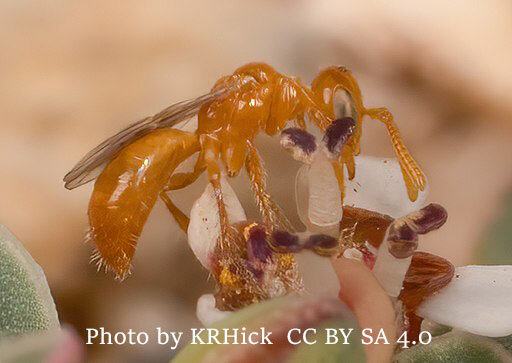What’s a bee?
In scientific terms, a bee is anything of Class Insecta in one of seven families within the Order Hymenoptera: Andrenidae, Apidae, Colletidae, Haicidae, Megachilidae, Melittidae, and Stenotritidae.
There are about 20,000 different bees worldwide.
It used to be that bees were vegetarian insects, closely related to Wasps, that, in the wild, rely on pollen from flowers as their protein source. But discovered fairly recently are carnivorous or “Vulture” bees. [i] All the meat-eating bees live in South America, so we can still say all bees in North America are vegetarian.
Wikipedia says “Bees differ from closely related groups such as wasps by having branched or plume-like setae (hairs), combs on the forelimbs for cleaning their antennae, small anatomical differences in limb structure, and the venation of the hind wings; and in females, by having the seventh dorsal abdominal plate divided into two half-plates.'‘ [ii]
Some bees can be difficult to see. The Perdita minima, native to the Sonoran Desert, thought to be the world’s smallest, is a bit less than 2mm in length. [iii] Compare that with what is claimed as the world’s largest bee, Megachile pluto, a native of Indonesia, (more commonly called Wallace’s Giant Bee), whose females sometimes reach 45mm in length.[iv]
In comparison, Apis mellifera (the western Honey bee), has queens that max out at 18-20mm while workers are usually in the range of 10-15mm.[v]
What’s a native bee?
There doesn’t seem to be a universally accepted definition. Most people intend it to mean bees that have always been here. Some people use a date while others use a historical event, as in bees that were here before the Europeans arrived.
At MEBW knowing an exact definition doesn’t worry us. Evolution continues. As long as humans played no part in a bee arriving in Maine, we’re happy to call that bee native.
How do you know what sort of bee you’re looking at?
Experienced bee observers can often quickly identify bees visually, using knowledge of what bees live in an area and what they look like. The accuracy of the identification will vary based on the experience of the observer – 70-80% sure is generally good enough. A few individuals may surpass 90% accuracy.
Those less experienced and also occasionally the experts too need samples to examine, sometimes under a dissecting microscope. Sample collectors must have a collection of really good photographs showing the bee from various perspectives, or the actual bee if an accurate identification is to be made.
Historically, specimens consisting of actual bees were killed and preserved for future examination. Those collections often ended up in Museums and Universities where the bees contained in them can be analyzed today.
[I] https://en.wikipedia.org/wiki/Vulture_bee, accessed 6/18/2022
[ii] https://en.wikipedia.org/wiki/Bee, accessed 6/18/2022
[iii] USDA/US Forest Service; https://www.fs.fed.us/wildflowers/pollinators/pollinator-of-the-month/perdita_minima.shtml, accessed 9/26/2021
[iv] Guinness World Records; https://www.guinnessworldrecords.com/world-records/82819-largest-species-of-bee; accessed 9/26/2021
[v] Carril, Olivia Messinger & Wilson, Joseph S; Common Bees Of Eastern North America; 2021, Princeton University Press



